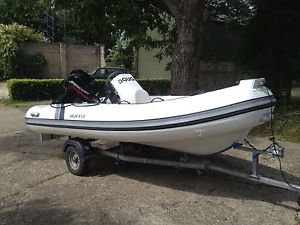Back to the main page Back to category Power Boats
boat details
Highfield Ocean Master 390 including Mercury 30hp 2 stroke & road trailer
Estimated price for orientation: 4 995 $
Category: Power Boats
Class:
Description Year of Registration: 2011 Trailer: Included Manufacturer: Highfield Use: Fresh Water, Salt Water Type: Rigid Inflatable Engine Type: Two Stroke Petrol Length (Feet): 12' 10" Engine Manufacturer: Mercury Beam (Feet): 6' 1"
De-rated from its 40hp counterpart, the Mercury 30 ELPTO was released locally in 1994 and is a twin cylinder, single-carburettor version of the three-cylinder, three-carbie 40-60hp range. It has the largest piston displacement of any two-stroke 30 and is a beautifully under-stressed motor that with regular maintenance should last a lifetime.Perhaps the most remarkable characteristic of the 30 ELPTO for a big twin is the low vibration levels across its entire rev range. Unlike the twin cylinder, single-carbie Tohatsu-built Merc 30 Lite and the Yamaha 30H (both premix motors), which vibrate below 1000rpm, the 30 ELPTO has vibration levels almost as low as Yamaha's three-cylinder 30D, which is the only other two-stroke 30 to have power trim and tilt.And whereas the 30D sports three carbies that require careful balancing to maintain correct engine tune, the 30 ELPTO has only one. In fact, the Merc is reminiscent of the old Suzuki DT40C that had two cylinders, one carbie and oil injection. The Merc also has electronic ignition timing advance whereas the 30D retains mechanical advance, but the manual recoil starter is omitted in electric start models, whereas the 30 Lite and 30H retains them.As with its larger oil-injected carbie counterparts, the 30 ELPTO has single-point oil injection, which varies the fuel/oil ratios from 50:1 at Wide Open Throttle down to 100:1 at Dead Slow Troll. The oil tank is undercowl with a sight glass in the upper cowl.The single-point system injects oil at the fuel pump, ensuring the throttle and choke butterfly valve shafts in the carburettor are lubricated and prevents the build-up of verdigris, unlike Yamaha's system, which injects oil at the reed valves.Mercury's system is also less susceptible to oil "gelling" in the feed line should different brands of oil be mixed together. For these reasons, Tohatsu also uses single-point injection in its carburetted models.
Description
| Year of Registration: | 2011 | Trailer: | Included |
| Manufacturer: | Highfield | Use: | Fresh Water, Salt Water |
| Type: | Rigid Inflatable | Engine Type: | Two Stroke Petrol |
| Length (Feet): | 12' 10" | Engine Manufacturer: | Mercury |
| Beam (Feet): | 6' 1" |
De-rated from its 40hp counterpart, the Mercury 30 ELPTO was released locally in 1994 and is a twin cylinder, single-carburettor version of the three-cylinder, three-carbie 40-60hp range. It has the largest piston displacement of any two-stroke 30 and is a beautifully under-stressed motor that with regular maintenance should last a lifetime.Perhaps the most remarkable characteristic of the 30 ELPTO for a big twin is the low vibration levels across its entire rev range. Unlike the twin cylinder, single-carbie Tohatsu-built Merc 30 Lite and the Yamaha 30H (both premix motors), which vibrate below 1000rpm, the 30 ELPTO has vibration levels almost as low as Yamaha's three-cylinder 30D, which is the only other two-stroke 30 to have power trim and tilt.And whereas the 30D sports three carbies that require careful balancing to maintain correct engine tune, the 30 ELPTO has only one. In fact, the Merc is reminiscent of the old Suzuki DT40C that had two cylinders, one carbie and oil injection. The Merc also has electronic ignition timing advance whereas the 30D retains mechanical advance, but the manual recoil starter is omitted in electric start models, whereas the 30 Lite and 30H retains them.As with its larger oil-injected carbie counterparts, the 30 ELPTO has single-point oil injection, which varies the fuel/oil ratios from 50:1 at Wide Open Throttle down to 100:1 at Dead Slow Troll. The oil tank is undercowl with a sight glass in the upper cowl.The single-point system injects oil at the fuel pump, ensuring the throttle and choke butterfly valve shafts in the carburettor are lubricated and prevents the build-up of verdigris, unlike Yamaha's system, which injects oil at the reed valves.Mercury's system is also less susceptible to oil "gelling" in the feed line should different brands of oil be mixed together. For these reasons, Tohatsu also uses single-point injection in its carburetted models.
